Springbank Clover

An Edible Springtime Wildflower with Hidden Strengths
by Torrey Douglass
When Spring’s wildflowers appear, keep an eye out for springbank clover, whose deep magenta or pink-purple hues add some snazz to the landscape. With the Latin name Trifolium wormskioldii, its common names include cow’s clover, coast clover, and sand clover. This versatile and beautiful plant can be found in spots that offer both moisture and sun–beside a creek, in a patch of sunny meadow that stays damp from runoff, in marshy areas next to ponds, or on the edge of seasonal wetlands. They are especially abundant after a wet winter. All parts of the plant, from the young leaves to the flower heads to the tender roots under the soil, have something to offer. Starting at the top, the flowers can be dried or used fresh to make a refreshing tea. The greens can be eaten raw in salads or steamed and seasoned with sea salt for a simple side dish. But the real bounty of this plant is hidden beneath the ground, where its nutritious and abundant rhizomes historically served as an important vegetable for Indigenous peoples from California to Western Canada. Rich in calcium, magnesium, iron, and other nutrients, the roots of springback clover were traditionally dried for eating later in the year, but they are good fresh, too, when they are similar in taste and texture to Chinese bean sprouts. They can be washed and added raw to salads, or fermented into a quick and tasty kimchi (see recipe on the right). The flowers attract all sorts of bees and butterflies, so be thoughtful about gathering the plants and leave plenty for the pollinators. Mature plants thrive when they are periodically divided and replanted, so it’s fairly easy to cultivate your own to beautify the view, sustain pollinators, and provide an abundance of flowers, greens, and rhizomes for eating.
Springbank Clover Kimchi
Ingredients
• 2 c Springbank clover fresh rhizomes
• 1 c shredded carrots
• Optional: ½ c additional diced veggies like radishes, bell peppers, celery
• 2 minced cloves of garlic
• 1 tsp chili flakes
• 1 tsp fish sauce
• 1 Tbsp salt
• 1/4 c mushroom broth or water
• 1 tsp grated fresh ginger
• Optional: sesame seeds for garnish
Instructions
Combine garlic, chili flakes, fish sauce, and salt, and set that aside for one hour. This is your kimchi mixture.
Combine all of the vegetables into a bowl and salt generously, then set aside for one hour. Rinse the vegetables, then add the kimchi mixture and combine well. Transfer to a vessel, add a weight to press the veggies down, then add enough mushroom broth or water to cover.
Keep it at room temperature for 24 hours before enjoying. The kimchi can be refrigerated for up to a week. Try it with roasted meats, as a stir-fry side, or alone as an invigorating snack.
Torrey Douglass is a web and graphic designer living in Boonville with her family. Her life’s joys include reading by the fire, cooking something delicious, and inspiring her dogs to jump into the air with uncontained canine happiness.
